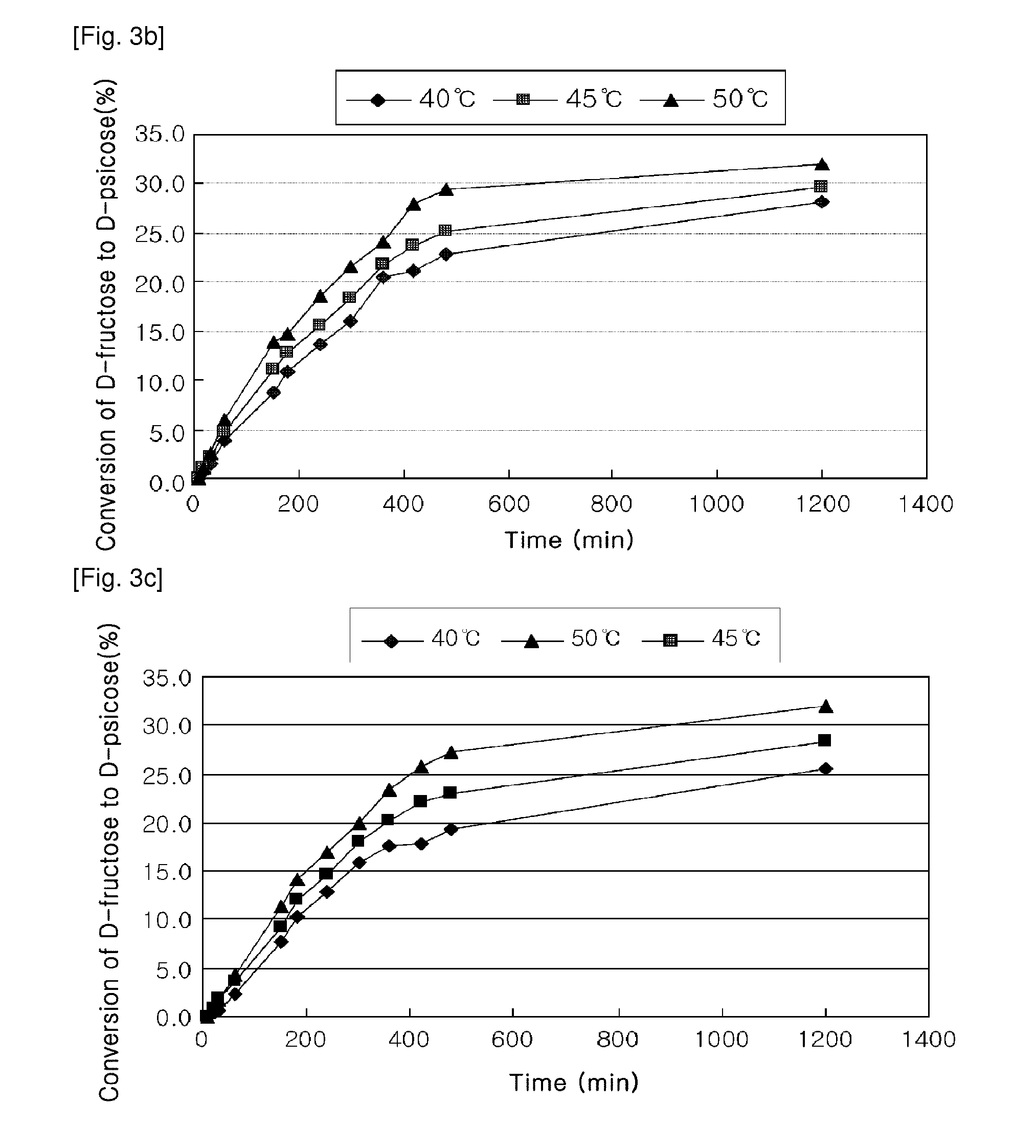Immobilization of psicose-epimerase and a method of producing d-psicose using the same
a technology of psicose and immobilization, which is applied in the direction of biochemical apparatus and processes, microorganisms, and processes based on bacteria, can solve the problems of unsuitable d-psicose production using such a recombinant i>e. coli/i> in terms of food safety, and the use of expensive d-fructose as a substrate for the production of d-psicos
- Summary
- Abstract
- Description
- Claims
- Application Information
AI Technical Summary
Benefits of technology
Problems solved by technology
Method used
Image
Examples
example 1
Recombinant Strain Expressing a Psicose-Epimerase
[0083](1) Preparation of a Recombinant Strain
[0084]The polymerase chain reaction (PCR) was carried out to amplify a gene encoding a psicose-epimerase by using a genomic DNA of Agrobacterium tumefaciens ATCC 33970 as a template and oligonucleotides of SEQ ID NOs: 9 and 10 with introduced PstI and XbaI restriction enzyme recognition sties, respectively, as primers. PCR conditions were as follows: after denaturation at 95° C. for 30 seconds, 26 cycles consisting of 30 seconds at 95° C., 30 seconds at 55° C. and 1 minute at 68° C., then extension at 68° C. for 10 minutes. For the mass expression of the psicose-epimerase encoded by the amplified gene, the amplified PCR product was digested with the restriction enzymes PstI and XbaI, and inserted into a shuttle vector pCJ-1 derived from Corynebacterium sp. bacteria (deposited with the Korean Culture Center of Microorganisms (KCCM), an international depository institution on Nov. 6 2004, und...
example 2
Immobilization of a Recombinant Strain and Preparation of D-Psicose
[0088](1) Immobilization of a Recombinant Strain
[0089]For the mass production of D-psicose, Corynebacterium glutamicum ATPE (KCCM 11046) expressing the psicose-epimerase derived from Agrobacterium tumefaciens and prepared in the above Example 1 was immobilized onto the carrier in this example. For the immobilization of the recombinant strain, the modification medium for Corynebacterium used in the Example 1 was first inoculated with the recombinant strain at an initial concentration of OD600=0.6 followed by the incubation at 30° C. for 20 hours. After the completion of the incubation, the resulting culture was subject to the centrifugation to recover the cells, which were resuspended in the 50 mM EPPS buffer (pH 8.0) to be 20%. The resuspended cells of the recombinant strain were added to 2% (v / v) of an aqueous sodium alginate solution. The resulting mixture was dropped to a 100 mM CaCl2 solution by using the syringe...
example 3
Preparation of D-Psicose from D-Glucose by Using the Immobilized Recombinant Strain / Enzyme
[0097](1) Productivity Depending on a Reaction Temperature and a D-Glucose Concentration
[0098]The XK16 packed-bed columns (16 mm×20 mm, Amersham pharmacia) were packed with the recombinant strain immobilized onto sodium alginate in the above Example 2 and 10 g of the immobilized D-glucose isomerase (Novozymes, Denmark), respectively, followed by the measurement of % conversion of D-glucose to D-psicose. In order to determine the optimal reaction condition for the two mixed enzymes, the conversion reaction of D-glucose to D-psicose was conducted under combined conditions of 40° C., 45° C., or 50° C. of a reaction temperature, and 100 g / L, 300 g / L, or 500 g / L of D-glucose concentration. FIG. 6 shows % conversion of D-glucose to D-psicose depending on changes in the reaction temperature and the substrate concentration. According to FIGS. 6a to 6c, different from the epimerization reaction for D-ps...
PUM
| Property | Measurement | Unit |
|---|---|---|
| temperature | aaaaa | aaaaa |
| temperature | aaaaa | aaaaa |
| temperature | aaaaa | aaaaa |
Abstract
Description
Claims
Application Information
 Login to View More
Login to View More - R&D
- Intellectual Property
- Life Sciences
- Materials
- Tech Scout
- Unparalleled Data Quality
- Higher Quality Content
- 60% Fewer Hallucinations
Browse by: Latest US Patents, China's latest patents, Technical Efficacy Thesaurus, Application Domain, Technology Topic, Popular Technical Reports.
© 2025 PatSnap. All rights reserved.Legal|Privacy policy|Modern Slavery Act Transparency Statement|Sitemap|About US| Contact US: help@patsnap.com



